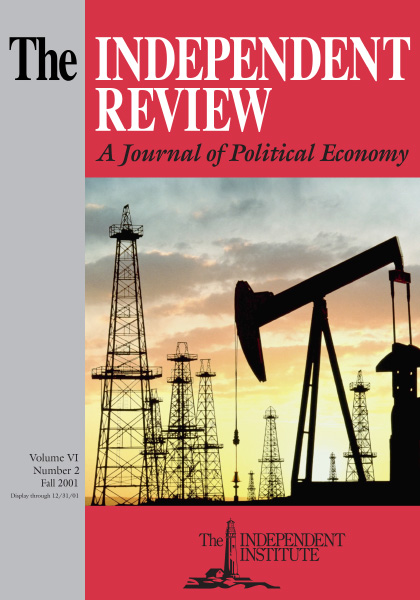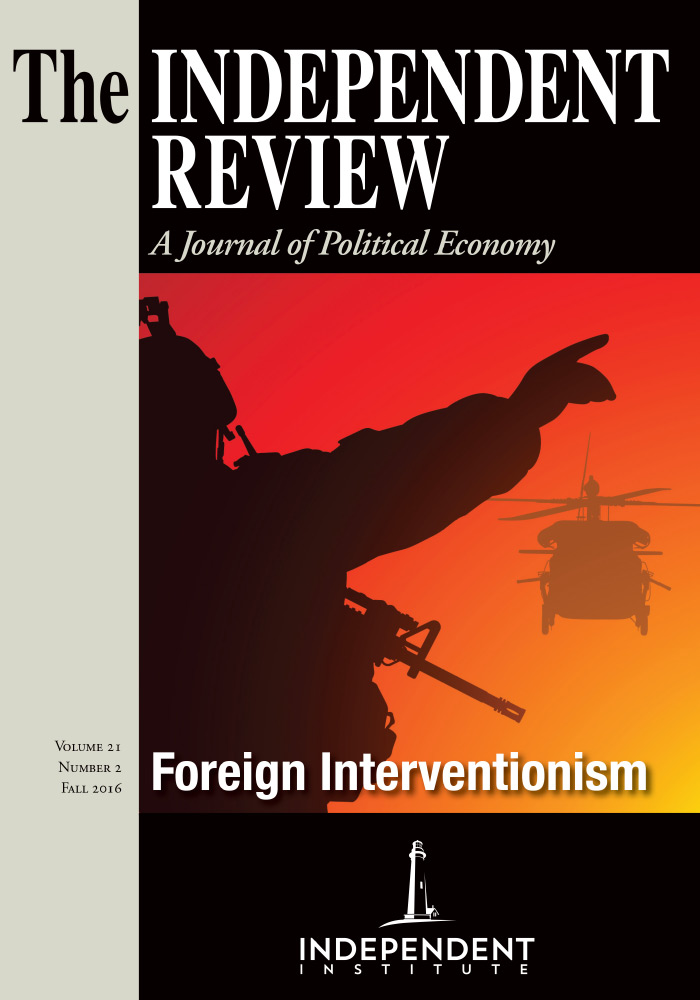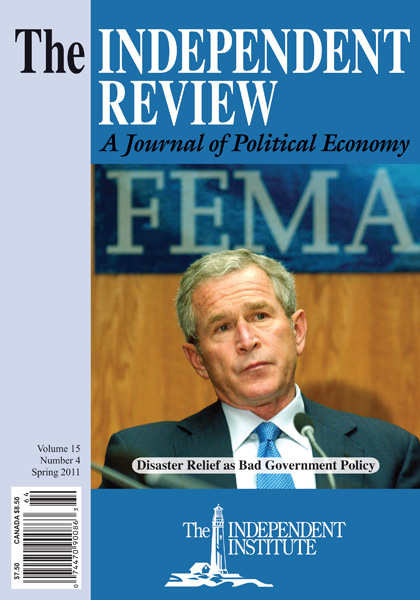Defense against terrorism requires spending priorities different from those favored throughout the Cold War and since its end. Unfortunately—and unsurprisingly, given its incentives—the military-industrial-congressional complex has been preparing to fight the last war rather than addressing America’s current security needs.
Article
As George W. Bush’s administration took office in January 2001, you could almost hear the sighs of relief coming from the Pentagon and the corporate headquarters of Lockheed Martin, Boeing, Raytheon, General Dynamics, Northrup Grumman, Litton Industries, and other big defense contractors. After all, the Bush campaign had championed a $45 billion increase in annual military spending over the next decade. Appearing at a Senate confirmation hearing on his nomination as secretary of defense, Donald Rumsfeld advocated an even greater increase, remarking that “it is not a time to preside and tweak and calibrate,” though the administration’s tactics dictated that the big increase not be requested immediately (Rumsfeld qtd. by Jaffe and Schlesinger 2001; see also Jaffe and McKinnon 2001). Just eleven days later, the press disclosed that “the dash for missile-defense profits is on” (Jaffe and Squeo 2001). Nor were the missile-defense-system contractors the only ones who stood to benefit from the new administration’s defense program. Bush’s budget, introduced at the end of February, called for an increase of $14.2 billion, or 4.8 percent, in defense spending, but the budget’s proposed “continency reserve” held additional funds that could be tapped by the military (Bush’s Budget Balance 2001, A14), and the Pentagon has been no stranger to supplemental appropriations. As the preliminary maneuvering proceeded, with an eye toward fiscal year 2003 and beyond, Rumsfeld’s staff produced a plan to increase the weapons-procurement budget by 42 percent over seven years “with big increases for fighter jets, ballistic-missile defense, cargo planes and bombers” (Jaffee 2001). Throughout the military-industrial-congressional complex (hereafter, the MICC), the pork-hawks preened their feathers and prepared to take flight.1
The Latest Cycle
The MICC, it seemed, was setting out on another of the recurrent upsurges that have marked the history of defense spending since the onset of the Cold War. The first such upsurge—the most significant one, in view of its long-term consequences—occurred concurrently with the Korean War, though much of it pertained to the build-up of forces intended for deployment in Europe and elsewhere, not in Korea. The second build-up financed the U.S. misadventure in Vietnam. The most recent upswing was the Reagan build-up of the 1980s, which receded in the first half of the 1990s. Examining what might be viewed as the Cold War norm or baseline of defense spending during the fiscal years 1955-1965 and 1974-1980, when neither substantial mobilization nor demobilization was occurring, we find that real defense spending during those years averaged $281 billion (dollars of 1999 purchasing power) per year.2 On a graph, the three upsurges and their subsequent abatements appear as discrete hills sitting on that Cold War plateau (Higgs 1994, 288).
If the Cold War had continued to the present, we might have expected that defense spending during the past several years would have returned to the level of the Cold War norm, and indeed it has done so. During the six fiscal years from 1995 through 2000, the average level of annual defense spending was $278 billion (dollars of 1999 purchasing power)—almost exactly equal to the Cold War norm.3
Such an equality, however fitting it might seem in the sense of conformity to a statistically descriptive pattern, raises a serious policy question: given that the Cold War ended a decade ago, why is the defense establishment plowing ahead as if nothing had changed, and even beginning to enlarge its bite on the taxpayer’s purse? After all, it was to fight the Cold War that the historically extraordinary magnitude of defense spending was ordained in the first place, back in the early 1950s. That immense rate of spending was continuously maintained, even when the United States was not engaged in a hot war or other military upsurge, one presumes, in order to meet continuing threats posed by the USSR, its satellites, and its proxies, and especially to deter an attack on the NATO domain by the mighty Soviet forces in Europe. Today, however, the Soviet Union is a receding memory; ten years have passed since it disintegrated. The Soviet forces that remained in the hands of the Russians have suffered decay, disorganization, and demoralization. In the words of Lt. General Alexander I. Lebed, “Russia doesn’t have an army anymore. It has only toy soldiers, formations of boys with no capacity.”4 Of the USSR’s formidable navy, “little remains but rusting surface vessels and old, undermaintained submarines” (Creveld 1999, 345). Moreover, the Russians, no longer the avowed enemies of the West, have entered into extensive economic, scientific, cultural, and even military cooperation with the United States and other western nations. In view of all these developments, where is the big present threat, the one so menacing that it requires military spending equal to that with which the United States waged the Cold War?
Is the United States Militarily Weak?
The United States suffers no shortage of defense Jeremiahs. In their circle, the Munich analogy remains ever fresh, the danger of appeasement and isolationism ever present. Thus, for example, retired Lt. General William E. Odom, though conceding that “today the Russian military does not present a serious threat to NATO,” has warned that Russia’s armed forces are “down but not out” (Odom 1996). (Don’t tell that story to the crew of the Kursk.) Former Secretary of the Navy John F. Lehman and Harvey Sicherman, writing in February 2001 and drawing on their forthcoming book America the Vulnerable, fretted about the erosion of U.S. military capacities and urged various manuevers “to steer clear of the ‘Pearl Harbor’ cycle whereby only a disaster brings effective action” (Lehman and Sicherman 2001). The title of one recently published alarm speaks for itself: While America Sleeps: Self-Delusion, Military Weakness, and the Threat to Peace Today, by Donald Kagan and Frederick W. Kagan (2001).
Conservative organizations such as the Heritage Foundation have never met a military budget big enough to satisfy them. In 1996, Heritage analyst Baker Spring perceived “a serious mismatch between [U.S.] security commitments and the military capabilities needed to fulfill those commitments.” Soon, he anticipated, the United States “will have to decide between remaining a global power capable of preventing wars or [sic] becoming a mere regional military power, condemned to fight and possibly lose them.” In his view, projected defense budgets placed the nation “on a forced march along the path to military weakness and withdrawal” (Spring 1996, 1, 7).
Neo-conservatives, worried about what they perceive to be the flabby character of contemporary Americans, have urged greater military spending as support for a Teddy Roosevelt-style interventionist foreign policy, notwithstanding the enormous costs of such forthrightly macho globalism and its negligible likelihood of success in carrying out the neo-con quest to spread “democracy” (Muravchik 1996; for a compendium of recent essays along these lines, see Kagan and Kristol 2000).
Although their fighting spirit no doubt merits a standing ovation, such observers of the contemporary military scene deserve low marks for their appreciation of the relevant facts. The United States today is anything but militarily weak. It bestrides the globe better equipped to defend its vital national interests than any preceding imperial power ever was. One has only to consider some pertinent comparisons.
According to data compiled by the Stockholm International Peace Research Institute (SIPRI), in 1999 the United States accounted for 36 percent of world military expenditure. U.S. allies Japan, France, Germany, the United Kingdom, and Italy ranked second through sixth, respectively, and, as a group, accounted for 26 percent. Russia ranked seventh, with military spending that amounted to 3 percent of the world total, and China ranked eighth, spending substantially less than Russia (SIPRI n.d.a.).5 Russia “experienced sharp cuts in its military expenditure and arms procurement during the 1990s” (SIPRI n.d.b.). At the end of the 1990s, the United States was spending twenty-two times more than a group of seven so-called rogue states—Iran, Syria, Iraq, Libya, North Korea, Cuba, and Sudan (CDI n.d.b.). Because world military spending fell faster than U.S. military spending between 1985 and 1999, the U.S. share of the world total increased, from 30 percent to 36 percent (CDI n.d.c.)
It is possible, of course, that the amounts spent might fail to reflect differences in actual military capabilities, but other data show that U.S. capabilities are genuine. Whether one considers active troop strength, reserve troop strength, heavy tanks, armored infantry vehicles, airplanes, helicopters, or major warships, the United States and its allies possess a preponderance of the warriors and the tools of war, greatly exceeding the troop strengths and the number of weapons platforms in the hands of all potential adversaries combined (CDI n.d.d.). Beyond this numerical dominance, the United States and its allies possess important additional advantages of superiority in weapons technology as well as in communications, intelligence, logistics, training, maintenance, and mobility.
Listening to recent defense critics and presidential challengers, we might suspect that U.S. forces lack readiness to fight, but for the most part such suspicions lack a sound basis. Readiness, as former Assistant Secretary of Defense Lawrence J. Korb, has commented, “is a slippery and poorly understood concept” as well as “a hot-button political issue, subject to unlimited manipulation.” In 1995, Korb concluded that “the current readiness gap, like others since the 1970’s, was designed and manufactured by the Pentagon to serve its political agenda—to maintain the cold war status quo” (Korb 1995, 40-41; see also Isenberg 1995). Other analysts, writing from a variety of ideological positions, have reached similar conclusions with regard to more-recently alleged readiness gaps (O’Hanlon 1996; Sapolsky and Gholz 1999, 43; Easterbrook 2000; Eland 2000).
The argument that without a substantial military buildup the United States will soon find itself unable to defend its vital national interests simply cannot withstand scrutiny. Now that the USSR has fallen apart politically, economically, and militarily, no great threat looms.6 Yes, of course, serious new threats may arise—lately the scaremongers have served up China as the bugbear du jour—and wise management of the defense establishment dictates that efforts be made to anticipate such threats and to prepare to meet them. Yes, the world remains a dangerous place, as the conservatives never tire of reiterating, but which of the existing dangers constitutes a serious threat to the vital national interests of the United States? Unless one defines those interests in an absurdly expansive, globally imperious manner, it seems clear that the United States is now well prepared to deal with all genuine present and prospective military threats. Of course, the United States lacks the power to resolve every dispute among the world’s warring ethnic groups, to rescue every unfortunate victim of human or natural disaster, to set every primitive nation on a smooth road to modern democratic capitalism. But no such power could be achieved in any event, and we would be foolish to gauge the adequacy of the U.S. defense establishment by such grotesquely bloated standards. To protect U.S. citizens and their property within their national territory from external aggression, the present forces are more than sufficient. One suspects that, down deep, nearly all those who advocate increased military spending understand that reality. Perhaps, nonetheless, they have other reasons to favor a big military buildup.
If the Nation Were Truly Imperiled, Would They Manage Defense this Way?
The U.S. defense establishment must be enormous and correspondingly expensive, one presumes, because the nation faces grave threats from its enemies abroad. Ostensibly, we are dealing with, in the words of Heritage analyst Baker Spring, a “potentially life-or-death issue” (Spring 1996, 7). But you have to wonder: if a genuine threat exists, why are defense decision-makers managing the military establishment in such a slipshod and irresponsible manner? If the nation’s security is really at stake, why do the national-security elites treat defense resources as if those resources served only one purpose—namely, to feather the various parties’ own political, bureaucratic, and economic nests? Danger is supposed to focus the mind. Why hasn’t it?
Mismanagement of defense procurement is legendary. Over the years, several so-called blue-ribbon commissions, each composed of zealous, well-informed experts, have investigated the acquisition of military goods and services. Their reports have identified the same shortcomings again and again; their recommendations make for redundant reading. The Pentagon’s standard response has been to make profuse promises followed by cosmetic changes, then to hunker down until the disturbers of the status quo lose interest, as they invariably do. The 1955 Hoover Commission, the 1970 Fitzhugh Commission, and the 1986 Packard Commission—all rang the same tocsin (Kovacic 1990). The fifteen-year periodicity of the appointment of such commissions held true to form on October 31, 2000, when President Bill Clinton signed legislation “to set up a 12-member commission with the aim of recommending improvements to the sometimes troubled relationship between the federal government and the nation’s aerospace and defense companies” (Commission to Study Relationship Between U.S., Defense Firms 2000). Disinterested observers who know something about the history of such futile endeavors face a vexing choice: laugh or cry? In 1986, General James P. Mullins, former head of the Air Force Logistics Command, made a statement that remains as valid today as it was fifteen years ago: “we’re still living in the past in the area of weapons procurement and support. We don’t do things differently today. We do them just like we did them decades ago—in another day and age” (Mullins 1986, 49). Lawrence Korb, formerly a high-ranking DoD official, has opined that “getting the Pentagon to be more businesslike could save about $100 billion over the next five years” (Korb 1997, 25), but what incentive exists to elicit businesslike behavior from a vast bureaucracy fueled by taxpayer money and accountable to neither customers nor shareholders?
In any event, the Department of Defense lacks the basic information about its own affairs necessary to conduct them in a businesslike way. Twenty years ago, Air Force whistle-blower Ernest Fitzgerald discovered that “feeble audit control by the government was one of the great flaws that allowed the whole scandalous system to flourish” (Fitzgerald 1989, 165). That weakness has persisted. On April 16, 1998, Eleanor Hill, the Pentagon’s inspector general, testified to Congress: “I cannot yet report to you that the Department has successfully corrected the many shortcomings in its accounting and financial systems. The financial statement data for most DoD funds remain unreliable and essentially not in condition to audit” (Hill qtd. by Council for a Livable World Education Fund n.d.a.). Just imagine what would happen to the share values of General Electric or Exxon if auditors discovered those companies’ accounts to be in such condition.
The official overseer of the Department of Defense, of course, is Congress. Yet Congress, everyone agrees, is more a problem than a solution. A moderate-size library could be filled with books, articles, and reports detailing congressional mismanagement of the defense program.7 As always when one uses the term “mismanagement” in this context, one must recognize that the actions qualify as mismanagement only in relation to the ostensible objective of producing the most national security from the resources made available for that purpose.
As a rule, however, the actual objective of congressional actions is the reelection of incumbents, and viewed in that perspective the actions make good sense. In countless ways, big and small, members of Congress treat the defense budget as a big slush fund to be used for winning the favor of constituents and others whose support would improve the members’ reelection prospects. As Richard Stubbings, a long-time defense analyst at the Office of Management and Budget, has observed, “this concern for the public-works aspect of the budget—this intramural scramble for resources—often leaves the Congress unable or unwilling to make hard choices on defense issues, particularly on issues with large dollar implications” (Stubbing with Mendel 1986, 90).
Each year Congress adds billions of dollars to the request submitted by the Department of Defense. Some of the add-ons amount to nothing more than a thinly veiled hoax with which the Pentagon plays along—much of the funding for National Guard and Reserve equipment and for military construction projects, for example, belongs in this category (Cottle 1998, 58-59). Other add-ons by Congress, however, amount to overrides of the military authorities’ judgment, often for obvious pork-barrel projects. As a DoD budget document notes, “unrequested spending is especially damaging when it fails to take account of the future spending that it will generate” (Chapter 21 n.d.). Seawolf attack submarines, B-2 stealth bombers, and V-22 Osprey tilt-rotor aircraft come readily to mind in this connection.
A sure sign of congressional hanky-panky is the addition of funds by the conference committee on the defense appropriations bills. Conferees throw in personal favorites not requested by the Pentagon and not included in either the House bill or the Senate bill being reconciled. In the FY 2001 budget, for example, the conference committee added almost $350 million for a long list of pet projects, supplementing the $3,313 million of add-ons already approved by the House and the Senate in their separate bills (CDI n.d.e.).
Perhaps the clearest case of all pertains to congressional obstruction of military-base closures. To fight World War II, the United States created an armed force of more than twelve million men and women and a multitude of bases to accommodate them and their equipment. After the war, the armed forces shrank drastically, and the number of bases greatly exceeded the number needed; hence, the closure of bases became a routine activity, though never a popular one with the members of Congress in whose districts the bases were being closed. Finally, between 1977 and 1987, an obstinate Congress brought major base closures to a complete halt (Twight 1990). In 1988, Congressman Dick Armey, with important support from Senator Barry Goldwater, managed to create and gain congressional approval of a clever arrangement for bringing about additional base closures, managed by a nonpartisan Commission on Base Realignment and Closure. Four rounds of the commission’s procedure have now been undertaken, resulting in 222 major and 291 minor base closures or realignments and yielding annual recurring savings of approximately $6 billion, according to the DoD’s estimate (CDI n.d.f.). Despite the success of the commission—or perhaps because of it—Congress lately has lost its taste for additional closures, although the armed forces, whose ranks have diminished even further during the past decade, continue to urge more closures in order to divert funds from the maintenance of unnecessary bases to other uses (Mayer 1999).
In examining congressional oversight of the defense program, it is easy to fall into thinking that Congress is the mischief-maker and the Pentagon the long-suffering soldier just trying to do his job, but such a view has little to recommend it. In fact, the military departments are no less culpable than Congress. DoD decision-makers are as self-interested as others involved in the defense program. Just consider that in 1998, after the active personnel strength of the military establishment had fallen by a third during the preceding decade, the DoD requested approval of fifty-four new slots for generals and admirals (Council for a Livable World Education Fund n.d.a.).
Conduct a thought experiment: imagine that you are the czar of the U.S. defense program, with plenary power to decide how the limited resources available for defense purposes will be used to protect the nation from powerful external enemies. Would you choose to purchase and maintain more than a hundred “luxury jets used to fly generals and admirals,” including seventy-one Learjets, thirteen Gulfstream IIIs, and seventeen Cessna Citations? (Congress report 2000). How about “234 golf courses maintained by the U.S. armed forces worldwide” (CDI n.d.g.)? Are such uses of resources consistent with the notion that the armed forces are making good use of the taxpayers’ money while dealing with life-and-death threats to U.S. national security?
No matter how objectionable Gulfstreams and golf courses may be as objects of military funding, however, they lie far from the heart of the Pentagon’s most momentous misallocation of resources. To appreciate the most consequential mismanagement, one must focus on the big items, starting with the division of funds among the military services.
Interservice rivalry is as old as the Republic. It can be, and has been, defended as an important element in generating innovation (Sapolsky and Gholz 1999, 41-43) and in maintaining morale among the troops. However, as Stubbing has commented, it “can go too far, especially when the services are unable to settle major disputes—over roles and missions, resources, and operations—in an efficient manner. Unfortunately, this has been the case throughout the post-World War II era” (Stubbing with Mendel 1986, 133). Creation of an independent Air Force in 1947 only complicated and exacerbated the traditional rivalries of the military departments.
On the back side of the Reagan buildup, in the 1990s, interservice rivalries became even fiercer, as each service adopted the posture, “Hold onto everything you’ve got and fight the other services to the death” (Ricks 1997; see also Killan 1997 and Mayer 1999, 33). One consequence has been a great deal of needless duplication of the R&D, production, and maintenance of weapons systems. Currently, for example, three competing tactical fighter aircraft and a variety of theater-missile-defense systems are being developed. Why, one might ask, must the Army, Navy, Air Force, and Marines each have its own tactical air force? Why maintain all the different medical corps and base structures? Surely costs could be lowered by the standardization of certain equipment, the combination of some R&D programs, and at least a selective sharing of repair facilities, depots, and the like (U.S. Senate 1985, 539-41).
Interservice rivalries find their resolution in peace pacts, or cartel agreements—the so-called Key West Accords of 1948 being the most noteworthy—that stipulate how the rivals will divide tasks or resources. That such an agreement has long been in effect with respect to the overall DoD budget seems plain. As Richard J. Sherlock observed in 1997, “The relative portions of the Pentagon budget assigned to the Army, Navy and Air Force have not varied more than 2% over the past 25 years. Today, the Army continues to receive approximately 24%, the Air Force 29%, and the Navy (including the Marine Corps) 30% of the overall Defense budget” (Sherlock 1997; see also Stubbing with Mendel 1985, 71-72).
How well has the armed-services cartel operated since Sherlock’s 1997 observation? As table 1 shows, nothing has changed recently. During the fiscal years 1998-2001, the spending percentages of the three major services never deviated by as much as two percentage points from the cartel norm. Notice, too, that during recent years the deviations from the norm that did occur left undisturbed the established relative positions of the major services; lately the percentage slice of each service has exceeded its cartel norm, and defense-wide organizations have absorbed the loss.
|
Table 1
Percentage Distribution of DoD Outlays, by Service, FY 1998-2001 |
|||||
|
|
|||||
| Service | 1998 | 1999 | 2000 | 2001 | Norm |
|
|
|||||
| Army | 25.2 | 24.4 | 25.5 | 25.2 | 24.0 |
| Navy & Marines | 30.5 | 31.5 | 31.0 | 31.0 | 30.0 |
| Air Force | 30.4 | 29.4 | 29.3 | 29.9 | 29.0 |
|
|
|||||
|
Source: Calculated from outlay data in U.S. Department of Defense, Office of the Under Secretary of Defense 1999, 1998. Cartel norm from Sherlock 1997.
|
|||||
Return now to the previously described thought experiment: you are the Pentagon czar, intent on managing the Department of Defense exclusively with an eye to the optimal employment of its budget in the service of maximizing national security. How likely is it that despite countless changes in specific threats, technologies, resource costs, and military experience, you would never have occasion to change the interservice distribution of total resources by more than a trivial amount? How likely is it that you would find it sensible even to preserve the traditional Army-Navy-Air Force arrangement itself?
The answers are obvious. Clearly, the management of the military establishment reflects not the outcome of a search for the optimal provision of national security, subject to an overall budget constraint. Rather, it reflects the outcome of a bureaucratic rivalry in which each competing organization strives to maintain—and succeeds in maintaining—its organizational integrity and its share of the loot regardless of whether an organizational redesign or a substantial redistribution of resources would enhance national security. Fifteen years ago, General Mullins reached the same conclusion, though he expressed it in vaguer and more forgiving language:
Like all large bureaucracies, the military-industrial complex does have its share of problems. It is particularly prone to focusing on internal, organizational interests often to the detriment of the output the organization is designed to produce. In other words, its structure and operation have often evolved without enough regard to its function. (Mullins 1986, 3)
Safely in retirement, Admiral Bill Owens, former vice chairman of the Joint Chiefs of Staff, recently felt free to recommend that the services be stripped of their control over the choice of new weapons. “If we don’t get some major reform . . . in the way we buy weapons systems,” he warned, “we will pass some critical point where we no longer can do what the nation needs us to do” (Owens qtd. by Weiner 2000).
The Nature of the Beast
The evidence presented in the preceding section, which composes only a small selection from the enormous amount that could have been adduced, suffices to answer the question I posed at the outset: no, if the nation were truly imperiled, defense decision-makers would not manage the military establishment as they do. Notwithstanding repeated exposés, critiques, and blown whistles, far too many grievous organizational defects have remained in place for decades, far too many seemingly inexcusable actions have been taken time after time. As an important Senate study concluded in 1985, “Past mistakes—whether in the procurement of a weapon system or in the employment of forces during a crisis—do not receive the critical review that would prevent them from recurring. . . . The lessons go unlearned, and the mistakes are repeated” (U.S. Senate 1985, 8). Evidently, the system remains impermeable to genuine reform for a reason; the status quo must be serving somebody’s interest.
The concept of the MICC is best understood as nothing more than a suggestion of who the main interested parties are. Members of Congress and the military authorities themselves we have already glimpsed in action, the former seeking for the most part to enhance their reelection prospects and the latter doing for the most part what good soldiers must do to climb the ladder of bureaucratic success. We come now to the “industrial” part of the complex. This is where we would have ended up anyhow, had we only complied with that ancient maxim of social-science research, “follow the money.”
Although the MICC shelters a variety of creatures—little rats as well as fat cats, hoot owls among the operation-and-maintenance accounts as well as lion-kings of the major R&D and procurement programs—it is the latter, the big defense companies whose activities are reported in the Wall Street Journal on any given day, who occupy the high ground. They are the prime contractors who preside over the design, production, and deployment of the fabulously expensive whiz-bang weapons systems that define the activities of a modern armed force: tanks, ships, aircraft, missiles, satellites, and high-tech equipment for carrying out surveillance, communication, and targeting. Table 2 presents some details about the contractors presently leading the pack.
|
Table 2
Top Ten DoD Prime Contractors, Fiscal Year 2000 |
|||
|
|
|||
| Company Awards | ($ billions) | Major Products | |
|
|
|||
| Lockheed Martin Corp. | 15.1 | F-16, AH-64 Apache, Trident and Hellfire missiles | |
| The Boeing Company | 12.0 | F/A-18, F-15, V-22 Osprey, Comanche, C-17 | |
| Raytheon Corp. | 6.3 | Patriot, AMRAAM, and Hawk missiles | |
| General Dynamics Corp. | 4.2 | Nuclear submarines, DDG-51 destroyer | |
| Northrop Grumman Corp. | 3.1 | B-2 bomber, F-15, F/A-18 | |
| Litton Industries, Inc. | 2.7 | DDG-51 destroyer, LHD amphibious assault ship | |
| United Technologies Corp. | 2.1 | Aircraft and helicopter engines, UH-60, C-17 | |
| TRW Incorporated | 2.0 | Electronic systems and support | |
| General Electric Co., Inc. | 1.6 | Aircraft and helicopter engines | |
| Science Applications International Corp. | 1.5 | Programmatic, logistical,and technical support | |
|
|
|||
|
Sources: U.S. Department of Defense n.d.a. and Center for Defense Information n.d.h.
|
|||
The big defense companies are, in General Mullins’s apt phrase, “where the babies come from.” As he explains,
The contractor has already often determined what it wants to produce before the formal acquisition process begins. . . . The contractor validates the design through the process of marketing it to one of the services. If successful, the contractor gets a contract. Thus, to a substantial degree, the weapon capabilities devised by contractors create military requirements. . . . For years now, as a customer for the prime contractors, [the military] has placed major emphasis on operational performance. The result was often adoption of immature technolo gies that are unreliable and difficult to support. (Mullins 1986, 91, 93)
Regardless of the type of weapon they wield, today’s U.S. warriors increasingly resemble space cadets. The V-22 Osprey’s cockpit, “with its bank of colored computer displays, . . . looks more like the flight deck of a modern jet-liner than a Spartan warbird” (Lunsford 2001). Brig. Gen. Russel L. Honore has complained recently that the Army’s M1A2 tank “is more like an F-16 jet fighter than it’s like an M1A1 tank, and this should sort of scare us” (Honore qtd. by Council for a Livable World Education Fund n.d.a.). Indeed it should scare us, in view of the half-educated boys at the controls of those multi-million-dollar behemoths (Stubbing with Mendel 1986, 131). More than twenty years ago, Secretary of Defense Harold Brown called attention to “the difficulties of training realistically with high-priced weaponry where the potential cost of losing or expending expensive weapons inhibits training realism” (Stubbing with Mendel 1986, 154). As the conduct of the 1999 war against Serbia revealed, U.S. combat commanders have become loathe to risk their hyper-expensive high-tech weapons too close to an actual enemy, even a pathetically inferior one.
Because both the contractor and the military service emphasize pushing the technical-performance envelope, a next-generation weapon typically takes ten, fifteen, or even twenty years to develop and, after finally being deployed, often works poorly and demands frequent, expensive maintenance. Military spokesmen try to cover up the failures of their cutting-edge weapons systems by faking test results and by lying about actual battlefield performance—anything to keep the program rolling. As Fitzgerald has reported, “Government officials, from the majestic office of the president to the lowest, sleaziest procurement office, lie routinely and with impunity in defense of the system” (Fitzgerald 1989, 312; see also Rasor ed. 1983, Rasor 1985, Burton 1993, Weiner 1996, and Lunsford 2001, A3). Col. James G. Burton, an Air Force officer who spent fourteen years at the Pentagon working with a handful of others trying to reform the system from within, ultimately concluded: “The business of buying weapons that takes place in the Pentagon is a corrupt business—ethically and morally corrupt from top to bottom. The process is dominated by advocacy, with few, if any, checks and balances. Most people in power like this system of doing business and do not want it changed” (Burton 1993, 232). Because so few powerful people want it changed, it has not been changed in any fundamental respect since it first took shape sixty years ago.8 Even the rare effort to reform the weapons-acquisition system that is not a mere public-relations ploy is almost dead on arrival. It twitches for a while and emits a big report, which is promptly filed and forgotten.
Notwithstanding everything that might be, and time and again has been, said about the deficiencies of the weapons-procurement process, the MICC forges ahead fundamentally inviolate, pouring a vast stream of taxpayer money into the acquisition and deployment of high-tech weaponry. Much of that money the big contractors find some way to absorb:
The techniques are many—buy-ins during competition, overpriced design changes, charges of unanticipated inflation, creative overhead accounting, sole-source contracts for follow-on modifications and spare parts—but the end result is the same: the large contractors survive and prosper without being held accountable for their performance. . . . At times the weapons acquisition process appears to be geared far more to protecting and fostering the major defense firms than to arming the military with high-quality weapons at a reasonable price. (Stubbing with Mendel 1986, 212)
Table 3 displays information on the costliest programs now under way. High-performance aircraft, ships, and missiles—those are the end products that bring in the big bucks. As a glance back at Table 2 confirms, the prime contractors of those products are the kingpins of the defense industry.
|
Table 3
Total Projected Program Costs of Selected Weapons Systems |
|||
|
|
|||
| Cost | Weapon System | Units | |
|
|
|||
| $219.0 billion | Navy-Air Force Joint Strike Fighter (JSF) | 3,000 planes | |
| $79.5 billion | Navy F/A-18E/F Hornet tactical fighter | 1,000 planes | |
| $70.9 billion | F-22 Air Force advanced tactical fighter | 440 planes | |
| $67.0 billion | Navy NSSN new attack submarine | 30 submarines | |
| $56.5 billion | Navy DDG-51 AEGIS destroyer | 57 ships | |
| $48.0 billion | Army RAH-66 Comanche helicopter | 1,292 helicopters | |
| $45.5 billion | Navy (Marine Corps) V-22 Osprey | 523 planes | |
| $44.4 billion | Air Force B-2 strategic bomber | 523 planes | |
| $41.4 billion | Air Force C-17 airlift aircraft | 21 planes | |
| $27.5 billion | Navy Trident II (D-5) missile | 120 planes | |
| $5.4 billion | CVN-77 nuclear aircraft carrier | 1 ship | |
|
|
|||
|
Sources: Selected Acquisition Reports, September 30, 1997,
and, for JSF and Comanche, cost estimates from Congressional
Budget Office, as compiled by Council for a Livable World Education
Fund n.d.b.
|
|||
Mulling over the information displayed in table 3, one might wonder: what sort of war, against what enemy, is the DoD preparing to fight? The answer is all too obvious. The Pentagon is preparing to fight the Cold War! Which is not really so surprising. An old aphorism tells us that the generals always prepare to fight the last war. And why not? All significant participants in the MICC continue to serve their own interests best by doing so (Sapolsky and Gholz 1999, 40, 43; Myers 2001).
As the prospect brightens for a new infusion of defense spending under the Bush administration, the leading aerospace companies anticipate receiving the biggest slice of those additional funds. The administration’s commitment to the development of a national-missile-defense system (NMD), in particular, promises to serve as a bottomless reservoir of corporate revenue for the top missile and electronics companies and their legions of subcontractors. According to a 1995 Congressional Research Service report, the Pentagon spent $70.7 billion on ballistic-missile-defense activities from FY 1984 through FY 1994, with very little to show for it (Physicians for Social Responsibility n.d.). Current projections place the cost of further NMD development at some $60 billion (International Institute for Strategic Studies n.d.), but only a dreamer would bet on that figure. If an effective NMD system is ever successfully produced—a big “if”—it will certainly have cost far more than the presently projected amount (Rose 2001). Unfortunately, that vast expenditure will have availed little or nothing in the provision of genuine national security, for an enemy can always choose to play a different game, foiling the best-laid NMD plans by firing a nuclear-armed cruise missile from a ship lying off New York, or by delivering a chemical or biological weapon of mass destruction tucked into a shipment of cocaine bound for Los Angeles, or by any number of other means immune to the missile-defense system (Dao 2001, Broad 2001, Eland 2001).
Conclusion
After a much-troubled career in the belly of the beast, Ernest Fitzgerald aptly commented that “peacetime military spending has little to do with foreign policy or the world situation . . . it is largely driven by domestic politics” (Fitzgerald 1989, 132). Which is to say, it is driven by a combination of ideology (especially among the fleeced taxpayers) and the self-interest of the millions of people who populate the MICC,9 for whom jobs, career advancement, reelection to political office and, above all, corporate profits turn on feeding more money into the maw of the MICC.10
Such facts of life do not imply that no national security gets produced; it does, even if it gets produced as a by-product and in an outrageously wasteful manner.11 The United States possesses a tremendously wealthy economy. The nation can, and does, sustain huge losses as resources pass through a MICC replete with foolishness, corruption, and cupidity, yet the nation still emerges on the other side of the process as a great power (Sapolsky and Gholz 1999, 43). The present U.S. military establishment is overwhelmingly the most powerful the world has ever known, and it has ample capacity to defend the nation against the military forces of any present or prospective foe in the kind of wars it is dedicated to fighting.
If an enemy should decide to wage a different kind of war, however, such as really serious terrorism, the armed forces are not configured to deal with that kind of threat (Kelley 2001); “the most powerful weapons available to them, including specifically the heavy ones which account for the bulk of their budgets, are entirely useless” against such a threat (Creveld 1999, 400), and everyone appreciates that the public-relations noises the Pentagon makes about anti-terrorism activities are not intended to be taken seriously by those in the know. The system has no constituency for the nitty-gritty, low-tech activity that an effective anti-terrorism program would call for, such as the maintenance of a massive global corps of unsavory informants on the ground; there’s no money in it for Lockheed Martin, Boeing, and the rest of the boys. But if you want to talk about a Star Wars system that stretches from here to Mars, hey, let’s talk!
Notes
1. The allusion is to my article “Beware the Pork-Hawk” (Higgs 1989).
2. U.S. Department of Defense, Office of the Under Secretary of Defense (1999, 202-03), figures adjusted to 1999 dollars according to the change in the implicit GDP deflator reported by U.S. Council of Economic Advisers (2000, 310). Throughout this article, unless otherwise indicated, “defense spending” refers to actual outlays, not to appropriations, budget authority, obligational authority, or any other accounting measure.
3. Defense spending data for fiscal years 1995-1999 from U.S. Department of Defense, Office of the Under Secretary of Defense (1999, 203), adjusted to 1999 dollars according to the change in the implicit GDP deflator reported by U.S. Council of Economic Advisers (2000, 310); defense spending data for fiscal year 2000 from U.S. Department of Defense, News Release, February 7, 2000, adjusted to 1999 dollars by assumption of 2 percent increase in the implicit GDP deflator between FY 1999 and FY 2000.
4. Lebed qtd. by Higgs 1995 (I have lost the original source of the Lebed quotation). See also Ignatius 1993.
5. According to data compiled by the Center for Defense Information (whose sources are the U.S. Department of Defense and the International Institute for Strategic Studies), both Russia and China spent substantially more than the SIPRI data show, but the difference has no substantive bearing on any conclusions reached in the present article. For the alternative data, see CDI n.d.a.
6. The only important exception to this declaration pertains to the continued maintenance of huge battle-ready nuclear forces by both the United States and Russia, but the threat posed by this condition relates to the potential for a catastrophic accident or a failure of the command-and-control systems, not to the likelihood that Russia will launch a deliberate attack on the United States. For informed observations on this danger by the former commander-in-chief of the U.S. Strategic Command, see Butler 1997; see also Hall 1998, Robbins 1999, and Forden 2001.
7. In addition to the essays by James M. Lindsay, Kenneth R. Mayer, and Charlotte Twight in Higgs 1990, see Higgs 1988 and 1989, Lindsay 1990 and 1991, Mayer 1991, and Stubbing with Mendel 1986, chap. 5.
8. On the origins of the modern military acquisition system, see Higgs 1993.
9. On the ideological impetus, see Higgs 1994 and Higgs and Kilduff 1993.
10. On the corporate profitability of defense contractors, see Higgs and Trevino 1992.
11. On national security as an incidental output, see Lee 1990.
References
Broad, William J. 2001. Smaller, Cheaper, Stealthier, Deadlier. New York Times, February 11, WK18.
Burton, James G. 1993. The Pentagon Wars: Reformers Challenge the Old Guard. Annapolis, Md.: Naval Institute Press.
Bush’s Budget Balance: Some Numbers Go Up, Others Go Down. 2001. Wall Street Journal, March 1, A14.
Butler, George Lee. 1997. Time to End the Age of Nukes. Bulletin of the Atomic Scientists, March/April, 33-36.
Center for Defense Information (CDI). n.d.a. Military spending data displayed at http://www.cdi.org/issues/wme/spendersFY01.html.
------. n.d.b. Last of the Big Time Spenders. At http://www.cdi.org/issues/wme/spendersFY01.html.
------. n.d.c. World Military Expenditure: U.S. Vs World. At http://www.cdi.org/issues.wme/.
------. n.d.d. Military Strengths of U.S., Allied, and Selected Other Armed Forces. At http://www.cdi.org/issues/wmke/oob.html.
------. n.d.e. Fiscal Year 2001 Add-Ons: Congress’ Unrequested Spending for the Pentagon. At http://www.cdi.org/issues/budget/add-ons01.html.
------. n.d.f. Base Realignment and Closure Statistics. At http://www.cdi.org/issues/brac/bracstat.html.
------. n.d.g. Tee-ing Off the Taxpayer. At http://www.cdi.org/adm/Transcripts/948/.
------. n.d.h. Fact Sheet: Top 15 U.S. Defense Contractors. At http://www.cdi.org/issues/usmi/complex/top15FY99.html.
Commission to Study Relationship Between U.S., Defense Firms. 2000. Wall Street Journal, November 1.
Congress report says military uses luxury jets for top brass. 2000. Seattle Times, May 30.
Cottle, Michelle. 1998. High on the Hog. New York Times Magazine, November 22, 58-59.
Council for a Livable World Education Fund (CLWEF). n.d.a. Pentagon: Part of the Problem as Well. At http://www.clw.org/ef/caution/pentagon.html.
------. n.d.b. Fiscal 1999 Military Budget at a Glance. At http://www.clw.org/ef/dodbud99.html.
Creveld, Martin van. 1999. The Rise and Decline of the State. Cambridge, Eng.: Cambridge University Press.
Dao, James. 2001. Please Do Not Disturb Us With Bombs. New York Times, February 11, WK18.
Easterbrook, Gregg. 2000. Apocryphal Now: The Myth of the Hollow Military. New Republic, September 11.
Eland, Ivan. 2000. A Hollow Debate on Military Readiness. Cato Institute Foreign Policy Briefing No. 62. Washington, D.C.: Cato Institute.
------. 2001. Bush’s Grandiose Missile Defense Scheme. Distributed via Internet by the Cato Institute, May 3.
Fitzgerald, A. Ernest. 1989. The Pentagonists: An Insider’s View of Waste, Mismanagement, and Fraud in Defense Spending. Boston: Houghton Mifflin.
Forden, Geoffrey. 2001. Reducing a Common Danger: Improving Russia’s Early-Warning System. Cato Institute Policy Analysis No. 399. Washington, D.C.: Cato Institute.
Hall, Brian. 1998. Overkill Is Not Dead. New York Times Magazine, March 15, 42-49, 64, 76, 78, 84-85.
Higgs, Robert. 1988. Hard Coals Make Bad Law: Congressional Parochialism versus National Defense. Cato Journal 8 (Spring/Summer): 79-106.
------. 1989. Beware the Pork-Hawk. Reason 21 (June 1989): 28-34.
------. 1993. Private Profit, Public Risk: Institutional Antecedents of the Modern Military Procurement System in the Rearmament Program of 1940-1941. In The Sinews of War: Essays on the Economic History of World War II, edited by Geofrey T. Mills and Hugh Rockoff, 166-98. Ames, Ia.: Iowa State University Press.
------. 1994. The Cold War Economy: Opportunity Costs, Ideology, and the Politics of Crisis. Explorations in Economic History 31: 283-312.
------. 1995. A Strong Defense Against Whom? St. Louis Post-Dispatch, February 6.
------, ed. 1990. Arms, Politics, and the Economy: Historical and Contemporary Perspectives. New York: Holmes & Meier for The Independent Institute.
Higgs, Robert, and Anthony Kilduff. 1993. Public Opinion: A Powerful Predictor of U.S. Defense Spending. Defence Economics 4: 227-38.
Higgs, Robert, and Ruben Trevino. 1992. Profits of U.S. Defense Contractors. Defence Economics 3: 211-18.
Ignatius, Adi. 1993. Russia Now Fields a Potemkin Military: Armed Forces, Except Nuclear Units, Grow Hollow. Wall Street Journal, July 2, A4.
International Institute for Strategic Studies. n.d. The Military Balance: The Regions: United States. At http://www.iiss.org/pub/mbregion.asp#arrow.
Isenberg, David. 1995. The Misleading Military “Readiness Crisis. Cato Institute Foreign Policy Briefing No. 35. Washington, D.C.: Cato Institute.
Jaffe, Greg. 2001. Pentagon Plan Sees 42% Rise In Arms Budget. Wall Street Journal, May 1, A28.
------, and John D. McKinnon. 2001. Defense-Budget Request Is Likely to Be Delayed. Wall Street Journal, February 6, A4.
Jaffee, Greg, and Jacob M Schlesinger. 2001. Pressure for More Defense Funds Collides With Other Bush Pledges. Wall Street Journal, January 19.
Jaffee, Greg, and Anne Marie Squeo. 2001. Missile-Defense Contract Contest Begins for Lucrative Projects. Wall Street Journal, January 30, A24.
Kagan, Donald, and Frederick W. Kagan. 2001. While America Sleeps: Self-Delusion, Military Weakness, and the Threat to Peace Today. New York: St. Martin’s Press.
Kagan, Robert, and William Kristol, eds. 2000. Present Dangers: Crisis and Opportunity in American Foreign and Defense Policy. San Francisco: Encounter Books.
Kelley, Matt. 2001. Pentagon: Anti-terrorist Units Unfit. Seattle Times, February 26.
Killan, Michael. 1997. Chief defines new Navy role. Seattle Times, May 6.
Korb, Lawrence J. 1995. The Readiness Gap. What Gap? New York Times Magazine, February 26, 40-41.
------. 1997. The Myth of the Two-Front War. Washington Monthly, March, 23-25.
Kovacic, William E. 1990. Blue Ribbon Defense Commissions: The Acquisition of Major Weapon Systems. In Arms, Politics, and the Economy: Historical and Contemporary Perspectives, edited by Robert Higgs, 61-103. New York: Holmes & Meier for The Independent Institute.
Lee, Dwight R. 1990. Public Goods, Politics, and Two Cheers for the Military-Industrial Complex. In Arms, Politics, and the Economy: Historical and Contemporary Perspectives, edited by Robert Higgs, 22-36. New York: Holmes & Meier for The Independent Institute.
Lehman, John F., and Harvey Sicherman. 2001. America’s Military Problems and How to Fix Them. Wire 9, distributed via Internet by the Foreign Policy Research Institute, February 17.
Lindsay, James M. 1990. Congressional Oversight of the Department of Defense: Reconsidering the Conventional Wisdom. Armed Forces & Society 17 (Fall): 7-33.
------. 1991. Congress and Nuclear Weapons. Baltimore: Johns Hopkins University Press.
Lunsford, J. Lynn. 2001. Osprey Under Fire. Seattle Times, February 20.
Mayer, Kenneth R. 1991. The Political Economy of Defense Contracting. New Haven: Yale University Press.
------. 1999. The Limits of Delgation: The Rise and Fall of BRAC. Regulation 22: 32-38.
Mullins, James P. 1986. The Defense Matrix: National Preparedness and the Military-Industrial Complex. San Diego: Avant Books.
Myers, Steven Lee. 2001. Getting More Bang for the Armed Forces Buck. New York Times, February 18, WK4.
Odom, William E. 1996. Russia’s Military: Down but Not Out. Wall Street Journal, August 27.
O’Hanlon, Michael. 1996. Ready for Action. Brookings Institution In Brief, December 29.
Physicians for Social Responsibility. n.d. Issue Brief: Ballistic Missile Defense (BMD). At http://www.psr.org/bmd.htm.
Muravchik, Joshua. 1996. The Imperative of American Leadership: A Challenge to Neo-Isolationism. Washington, D.C.: American Enterprise Institute.
Rasor, Dina. 1985. The Pentagon Underground. New York: Times Books.
------. ed. 1983. More Bucks, Less Bang: How the Pentagon Buys Ineffective Weapons. Washington, D.C.: Fund for Constitutional Government.
Ricks, Thomas E. 1997. Armed Forces Prepare to Battle One Another for Funds. Wall Street Journal, February 6, A16.
Robbins, Carla Anne. 1999. U.S. Nuclear Arsenal Is Poised for War--Is It the Right One? Wall Street Journal, October 15.
Rose, Peter H. 2001. Bush should tone down national missile defense. Seattle Times, March 14.
Sapolsky, Harvey M., and Eugene Gholz. 1999. The Defense Monopoly. Regulation 22: 39-43.
Sherlock, Richard J. 1997. New Realities, Old Pentagon Thinking. Wall Street Journal, April 24.
Spring, Baker. 1996. Will Clinton Pay the Price for America to Remain a Global Power? Heritage Foundation Backgrounder No. 1083, Washington, D.C.: Heritage Foundation.
Stockholm International Peace Research Institute (SIPRI). n.d.a. Military Expenditure: Table on the fifteen major spenders in 1999. At http://projects.sipri.se/milex/mex_major_spenders.html.
------. n.d.b. Military Expenditure: Recent Trends in Military Expenditure. At http://projects.sipri.se/milex/mex_trends.html.
Stubbing, Richard A., with Richard A. Mendel. 1986. The Defense Game: An Insider Explores the Astonishing Realities of America’s Defense Establishment. New York: Harper & Row.
Twight, Charlotte. 1990. Department of Defense Attempts to Close Military Bases: The Political Economy of Congressional Resistance. In Arms, Politics, and the Economy, edited by Robert Higgs, 236-80. New York: Holmes & Meier for The Independent Institute.
U.S. Council of Economic Advisers. 2000. Annual Report. Washington, D.C.: U.S. Government Printing Office.
U.S. Department of Defense. 2000. News Release, February 7. At http://www.defenselink.mil/news/Feb2000/b02072000_bt045-00.html.
------. n.d.a. 100 Companies Receiving the Largest Dollar Volume of Prime Contract Awards--Fiscal Year 2000. At http://web1.whs.osd.mil/peidhome/procstat/p01/fy2000/top100.htm.
------. n.d.b. Chapter 21. The FY 1999 Defense Budget and Future Years Defense Program. n.d. At http://www.dtic.mil/execsex/adr98/chap21.html.
U.S. Department of Defense, Office of the Under Secretary of Defense (Comptroller). 1999. National Defense Budget Estimates for FY 2000. March.
U.S. Senate, Committee on Armed Services. 1985. Defense Organization: The Need for Change. Staff Report. 99th Cong., 1st Sess., S. Prt. 99-86, October 16.
Weiner, Tim. 1996. Stealth, Lies and Videotape. New York Times, July 14.
------. 2000. How to Build Weapons When Money Is No Object. New York Times, April 16, WK3.
Acknowledgments: For useful comments on previous versions of this article, I thank Lee Alston, Randall Holcombe, Daniel Klein, and Charlotte Twight.
| Other Independent Review articles by Robert Higgs | ||
| Fall 2019 | Pressure-Release Valves in Participatory Fascism | |
| Winter 2018/19 | Two Worlds: Politics and Everything Else | |
| Fall 2018 | Against the Whole Concept and Construction of the Balance of International Payments | |
| [View All (62)] | ||




















